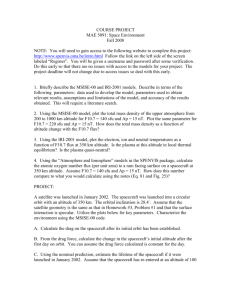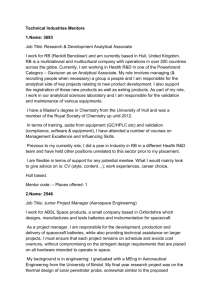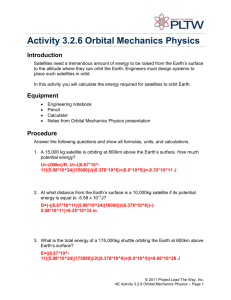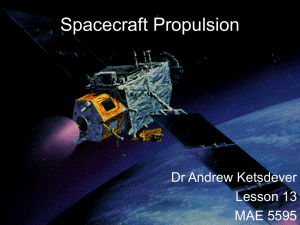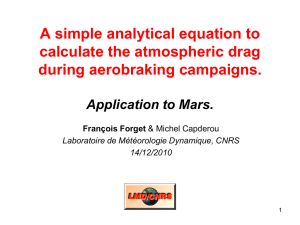Orbital-Mechanics-Questions
advertisement
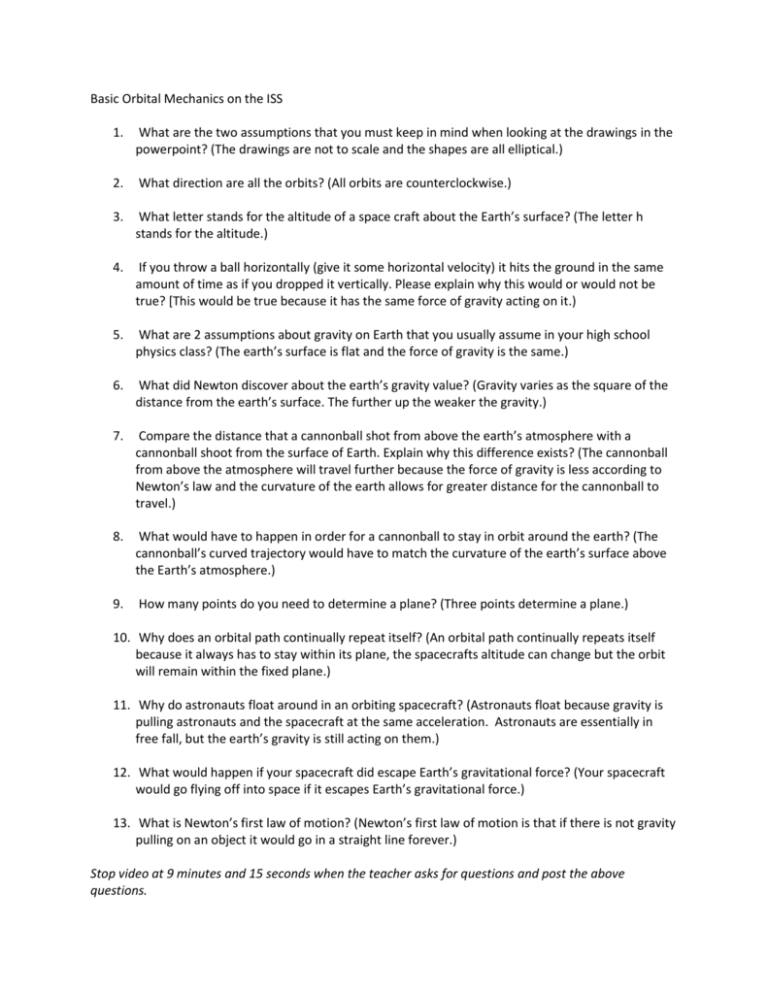
Basic Orbital Mechanics on the ISS 1. What are the two assumptions that you must keep in mind when looking at the drawings in the powerpoint? (The drawings are not to scale and the shapes are all elliptical.) 2. What direction are all the orbits? (All orbits are counterclockwise.) 3. What letter stands for the altitude of a space craft about the Earth’s surface? (The letter h stands for the altitude.) 4. If you throw a ball horizontally (give it some horizontal velocity) it hits the ground in the same amount of time as if you dropped it vertically. Please explain why this would or would not be true? [This would be true because it has the same force of gravity acting on it.) 5. What are 2 assumptions about gravity on Earth that you usually assume in your high school physics class? (The earth’s surface is flat and the force of gravity is the same.) 6. What did Newton discover about the earth’s gravity value? (Gravity varies as the square of the distance from the earth’s surface. The further up the weaker the gravity.) 7. Compare the distance that a cannonball shot from above the earth’s atmosphere with a cannonball shoot from the surface of Earth. Explain why this difference exists? (The cannonball from above the atmosphere will travel further because the force of gravity is less according to Newton’s law and the curvature of the earth allows for greater distance for the cannonball to travel.) 8. What would have to happen in order for a cannonball to stay in orbit around the earth? (The cannonball’s curved trajectory would have to match the curvature of the earth’s surface above the Earth’s atmosphere.) 9. How many points do you need to determine a plane? (Three points determine a plane.) 10. Why does an orbital path continually repeat itself? (An orbital path continually repeats itself because it always has to stay within its plane, the spacecrafts altitude can change but the orbit will remain within the fixed plane.) 11. Why do astronauts float around in an orbiting spacecraft? (Astronauts float because gravity is pulling astronauts and the spacecraft at the same acceleration. Astronauts are essentially in free fall, but the earth’s gravity is still acting on them.) 12. What would happen if your spacecraft did escape Earth’s gravitational force? (Your spacecraft would go flying off into space if it escapes Earth’s gravitational force.) 13. What is Newton’s first law of motion? (Newton’s first law of motion is that if there is not gravity pulling on an object it would go in a straight line forever.) Stop video at 9 minutes and 15 seconds when the teacher asks for questions and post the above questions. 1. Who discovered that planets orbit the sun in the form of ellipses? (Kepler discovered that planets go in elliptical orbits around the sun.) 2. What are the 3 conical shapes that Newton discovered that orbiting bodies can follow? (The three orbital shapes are ellipse, parabola, and hyperbola). 3. If you wanted to go to the moon, what conical shape would you need? (An elliptical orbit would send you to the moon, because the moon is in orbit around the Earth.) 4. If you wanted to fly by a planet what conical shape would you need? (A hyperbolic orbit would allow you to fly by a planet.) 5. If you wanted to escape the gravitational pull of the Earth what conical shape would you use? (A hyperbolic orbit would allow you to escape the gravitational pull of Earth.) 6. Which conic shape does not exist in the orbital real-world and why? (Parabolic orbits do not exist because you will never reach an infinite distance from the Earth.) 7. What is apogee? (Apogee is the furthest point of an orbit on the major axis from Earth) 8. What is perigee? (Perigee is the closest point of an orbit on the major axis from Earth) 9. Locate the major axis, perigee and apogee on the following diagram. 10. What does Ha refer to? (Ha refers to the distance of the point of apogee of an orbit from the surface of the Earth.) 11. What does Hp refer to? (Hp refers to the distance of the point of perigee of an orbit from the surface of the Earth.) 12. What term is used to describe the shape of an orbit? (eccentricity) 13. What is the eccentricity value of a circle? (0) 14. What is the eccentricity value of a parabola? (1) 15. What is the range of eccentricity values for an eclipse? (between 0 &1) Stop video at 19 minutes and 41 seconds when the teacher asks for questions and post the above questions. 1. If a spacecraft is at point x in the circular plane below, and you wanted Mission Control to know where it was, what directions could you give them to locate the spacecraft? Please be as specific as possible. * 2. If a spacecraft was located on the circle around the circular plane below, and you wanted Mission Control to know where it was, what directions could you give them to locate the spacecraft? * 3. If a spacecraft was orbiting the earth and you wanted Mission Control to know where it was, what directions could you give them to locate the spacecraft in orbit 1 below? How would the directions be different if you were in orbit 2 below? 4. There are six classical orbital elements that are used to describe an orbit and the location of a spacecraft in an orbit. List the six elements and describe how they are determined? a. Size of an orbit is measured by the length of the major and minor axis Major axis Minor axis b. Shape of the orbit is measured by the eccentricity value of the ellipse Circle Ellipse Eccentricity value = 0 Eccentricity value between 0 and 1 c. The location of the spacecraft in the orbit is determined by the time that has elapsed after the spacecraft has passed the point of perigee. d. Inclination of the orbit is determined by the angle between the plane of the equator and the plane of the orbit- the ISS inclination is 51.6 degrees Orbit plane 90 degree angle of inclination Equatorial plane e. Right Ascension of the ascending node tells you where the orbit crosses the equator Earth Orbital plane f. Argument of Perigee determines where the orbit’s closest point to the Earth is located *Perigee Stop video at 35 minutes and 10 seconds when the teacher asks for questions and post the above questions. The next section deals with how to change the orbital velocity, altitude and period (the time it takes a spacecraft to go around the Earth) of a spacecraft travelling around Earth. There is an important law of physics, called the Law of Conservation of Energy, which states that in a closed system energy is neither created nor destroyed. An orbiting spacecraft is a closed system, unless other forces of energy is added or subtracted from it. There is atmospheric drag that is an outside force acting on a spacecraft. However, for our purposes we will consider the atmospheric drag not significant enough to affect our spacecraft. 1. Can you think of what needs to occur in order to change the level of energy on a spacecraft? (Rocket boosters or collisions with objects have the ability to change the level of energy on a spacecraft.) 2. What are the two components of mechanical energy? (Mechanical energy is made up of kinetic and potential energy.) Kinetic energy is directly proportional to the velocity of an object. The faster an object goes the greater its kinetic energy. Potential energy is directly proportional to the altitude of an object. A greater altitude of an orbit increases the potential energy. 3. The mechanical energy of an object in a closed system remains constant according to what law of physics? (The Law of Conservation of Energy states that in a closed system energy is neither created nor destroyed.) 4. How does an increase in the altitude of a spacecraft change the period (time it takes for a spacecraft to travel around the earth) of an orbit? (The period of an orbit is related to the altitude of the orbit. The greater the altitude the greater the time it takes to orbit the Earth given a constant velocity.) 5. What is a geosynchronous orbit? (A geosynchronous orbit is when the time it takes for a spacecraft to rotate around Earth is the same as Earth’s rotational period.) 6. The ISS travels at an altitude of 160 nautical miles above the earth. This allows the ISS to rotate around the earth every 90 minutes. How many rotations does the ISS do in 24 hours? (24 hours X 60 minutes in an hour = 1440 minutes in a 24 hour period/90 minutes per period = 16 rotation per day.) 7. The orbital velocity of a spacecraft (kinetic energy) decreases as the altitude (potential energy) increases. What law of physics does this follow? (The Law of Conservation of Energy for a closed system says if the kinetic energy is decreased then the potential energy is increased.) 8. In an elliptical orbit the altitude of the spacecraft varies. Because of the Law of Conservation of Energy the velocity of the spacecraft must vary to maintain the conservation of energy. At perigee does the velocity increase or decrease and why? (At perigee the altitude decreases so that the velocity must increase to maintain the conservation of energy) 9. When you are in a spacecraft orbiting around earth the center of the earth is considered your local down vertical direction. The local horizontal direction is how many degrees to the vertical direction. (Horizontal lines are always 90 degrees to vertical lines.) Stop video at 45 minutes and 40 seconds when the teacher has the students take a break and post the above questions. 1. How many feet are there in a mile? (5280 feet) 2. How many feet are there in a nautical mile? (~ 6076.12 feet) 3. Why do you think distance for the ISS is measured in nautical miles? (Many nations use nautical miles to measure distances in air and sea travel.) 4. Orbital mechanics involves the ability of a spacecraft to change its altitude, velocity and periods. Why do you think it would be important to be able to control the altitude of a spacecraft orbiting earth? (One reason that it may be important to change the altitude of a spacecraft’s orbit is to avoid space debris.) 4. Why do you think it would be important to be able to control the velocity of a spacecraft orbiting earth? (In order for a spacecraft to return to Earth a change in velocity must occur.) 5. What is a burn? (A burn is the igniting of a rocket on a spacecraft.) 6. Why does the potential energy not change at the point of the burn? (A burn is considered to be instantaneous so the altitude does not change at the point of the burn only.) 7. What happens to the velocity of the spacecraft when there is a burn? (The velocity of a spacecraft either increases or decreases depending on the direction of the burn.) 8. What happens to orbital altitude when the burn increases the velocity and mechanical energy of the spacecraft? (When mechanical energy is increased the orbital altitude (potential energy) increases everywhere except where the burn took place.) 9. What happens to orbital altitude when the burn decreases the orbital velocity and mechanical energy of the spacecraft? (When the mechanical energy is decreased the orbital altitude decreases everywhere except where the burn takes place.) 10. The burn point must be a point in both the original and the new orbit. Why is this true? (The burn point is common to the original and new orbits because the new orbit must stay within the original orbital plane. The altitude can change but not the orbital plane.) 11. Name the two kinds of burns that change the altitude of a spacecraft? (Posigrade and retrograde burns increase and decrease the altitude of a spacecraft respectively.) 12. What kind of burn is pictured below? (the dotted orbit is the new orbit) (Posigrade burn) 13. Draw a picture of what a retrograde burn would look like? Stop video at I hour 4 minutes and 12 seconds when the teacher asks for questions and post the above questions. 1. How many burns do you need to transfer from one circular orbit to another circular orbit in the same plane? (2 burns) 2. What does a Hohmann orbital transfer do? (A Hohmann orbital transfer can increase or decrease the circular orbit of a spacecraft within the same plane.) 3. What kinds of burns are needed to increase the circular orbit of a spacecraft? (posigrade) 4. What kinds of burns are needed to decrease the circular orbit of a spacecraft? (retrograde) 5. If the first burn of a Hohmann transfer is at the point of perigee, where does the second burn have to occur? (apogee) 6. How can a spacecraft change planes? (A spacecraft can change planes by doing burns at the two nodes of intersection of the original and new orbital planes.) 7. Why is it not realistic for a spacecraft to change planes once in orbit? (It requires a huge amount of fuel to change the direction of the velocity one degree. Spacecraft once in orbit do not have enough fuel to change planes.) 8. What is the name of the theorem that allows the shuttle to rendezvous with the ISS? (Lambert Theorem) Stop video at 1 hour 19 minutes and 51 seconds when the teacher asks for questions and post the above questions. The next sections are about launch windows which are not vital to our study of orbital mechanics on the ISS. Therefore, stop the video at 1 hour, 16minutes and 51 seconds and the powerpoint after slide 23 on Lambert Theorem. The video if played to the end is 1 hour 50 minutes.
